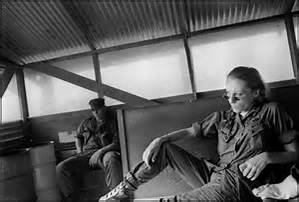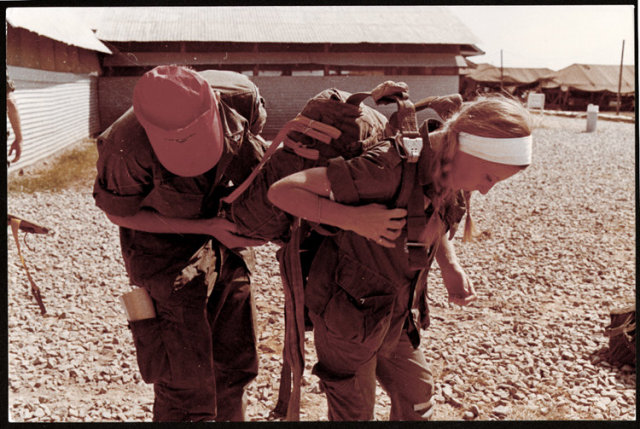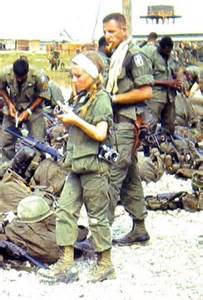The Vietnam War was noticeably different than all other wars in American history. Unlike World War II, Vietnam was fought in one place by mostly American soldiers. Warfare was guerrilla-style in the jungle, not on battlefields. The Vietnam War was the biggest event of our generation. It was also the first war in American history, so accessible to reporters that they flocked to Southeast Asia in droves for a chance to be break the biggest story ever to come out of the war.
For many female reporters, they tried everything to get their employers to send them to Vietnam to cover the war. Being denied, many went on their own as freelancers paying their own way. War being an equal opportunity employer, scores of women joined the procession of men traveling as war correspondents during the 1960’s and early 1970’s.
High on the list of great unanswered questions is whether women and men, apart from physique, really differ all that much. For journalists, a spin-off question is how news coverage changes, if at all, as women more fully integrate the field.
The women were gutsy risk-takers lusting for adventures in the jungles of Southeast Asia. Together, they transformed the role of women as war correspondents from something unheard of to being the norm.
Once on the scene, the women correspondents and their work didn’t seem – at least at first glimpse – all that different from their male colleagues.
They braved unspeakable dangers, not only from shrapnel and gunfire but also from leeches and parasites, blisters and swollen limbs, fever and malaria, exhaustion and emotional upheaval, to cover every kind of story from battlefields to street uprisings.
Military records indicate that upwards of 300 women were accredited to cover the war in the decade between 1965 and 1975. Of those 300, a total of about 70 women are identifiable as correspondents by their published or broadcast reports about the war. And their work won practically every prize in the book, from Polk Awards (Emerson, Dickey Chapelle and photographer Catherine Leroy) to the Emmy (Trotta) to the Pulitzer (FitzGerald).
Being a war correspondent was often considered the most dangerous form of journalism, yet, female correspondents got close enough to the action to provide written accounts, photos, or film footage. These factors produced military coverage the likes of which had never been seen or anticipated, with explicit coverage of the human suffering produced by the war available right in the living rooms of everyday people.
Here’s a brief glimpse of several female journalists who humped the bush alongside infantry soldiers on their quest for the big story:

 Dickey Chapelle – (March 14, 1919 – November 4, 1965).
Dickey Chapelle – (March 14, 1919 – November 4, 1965).
American photojournalist known for her work as a war correspondent from World War II through the Vietnam War. She was a writer for the National Observer and spent much of her time on patrols with the Marines. Chapelle was killed on November 4, 1965 while on patrol with a Marine platoon during Operation Black Ferret, a search and destroy operation 16 km south of Chu Lai, Quang Ngai Province, I Corps. The lieutenant in front of her kicked a tripwire boobytrap, consisting of a mortar shell with a hand grenade attached to the top of it. Chapelle was hit in the neck by a piece of shrapnel which severed her carotid artery; she died soon after.
Her last moments were captured in a photograph by Henri Huet. Her body was returned to the U.S. with an honor guard consisting of six Marines, and she was given full Marine burial. She became the first female war correspondent to be killed in Vietnam, as well as the first American female reporter to be killed in action.
Jurate Kazickas paid for her one-way ticket to Saigon with the $500 prize money she won on a television quiz show, Password. Kazickas traveled to Vietnam in 1967 at the age of 24 as a freelance journalist.
When she landed in Vietnam, she got her press card and explored the country. Kazickas travelled on military planes, ships, and aircraft carriers without a problem. While the older generals were less inclined to take her or any other woman along with them into combat, the younger 18-20 year-old soldiers were happy to have a woman reporter by their side. Kazickas didn’t know what she wanted to write about when she first arrived in Vietnam. She knew that she didn’t want to follow the big stories, so she wrote about the impact of Dear John letters on soldiers. Kazickas soon found the confidence to write what she wanted and spent her time with patrols on the front line of combat writing about what it was like to risk your life. She said she tried to carry her own weight when she was with the patrols.
Jurate Kazickas witnessed the carnage of Con Thien in July 1967 and was later wounded at Khe Sanh during an artillery attack; she still carries a piece of shrapnel in her derriere. After sustaining a “humiliating” wound to her buttocks, Kazickas was sent back to the United States. The military did not send her flowers. In fact, a general commented, “She got what she asked for.”

 Denby Fawcett, a 26-year-old filing battlefield stories for the Honolulu Advertiser in 1967, unwittingly became the focus of a tug-of-war between women and the military. Even though women in Vietnam easily got press credentials, they were not always welcomed on the front lines of combat, especially early in the war.
Denby Fawcett, a 26-year-old filing battlefield stories for the Honolulu Advertiser in 1967, unwittingly became the focus of a tug-of-war between women and the military. Even though women in Vietnam easily got press credentials, they were not always welcomed on the front lines of combat, especially early in the war.
She once traveled out to a remote army base in the Central Highlands. Gen. William Westmoreland, commanding officer for U.S. troops, helicoptered into the base on short notice to boost morale of the troops, who had just suffered 64 casualties. As he mingled with the soldiers, Westmoreland did a double-take: there was Fawcett, a woman he recognized from back home. Her mother, Suzanne, played tennis back in Honolulu with Westmoreland’s wife, Kitsy. The general asked Fawcett how long she had been there. Several days, she replied.
Fawcett later learned that the seemingly casual encounter led Westmoreland to decide that women should no longer be allowed to stay overnight in the field. For the women war correspondents, such a directive would have been career death since it often was impossible to get to a battle location for a story and then back to Saigon the same day. Fawcett, now a political reporter for KITV-TV in Honolulu.

 Catherine Leroy (1945 – 8 July 2006) was a French-born photojournalist and war photographer, whose stark images of battle illustrated the story of the Vietnam War in the pages of Life magazine and other publications
Catherine Leroy (1945 – 8 July 2006) was a French-born photojournalist and war photographer, whose stark images of battle illustrated the story of the Vietnam War in the pages of Life magazine and other publications
On arrival in Saigon, Leroy met the photographer Horst Faas, bureau chief of the Associated Press. A year later she became the first accredited journalist to participate in a combat parachute jump, joining the 173rd Airborne Brigade in Operation Junction City. Two weeks after the battle for Hill 881, she was wounded with a Marine unit near the demilitarized zone. In 1968, during the Tet Offensive, Leroy was captured by the North Vietnamese Army. She managed to talk her way out and emerged as the first newsperson to take photos of North Vietnamese Army Regulars behind their own lines. The story made the cover of Life Magazine.
Catherine was brought up in a convent in Paris. She was moved by images of war she had seen in Paris Match, and decided she wanted to travel to Vietnam to “give war a human face.” At the age of 21 booked a one-way ticket to Laos in 1966, with just one Leica M2 and $100 in her pocket.
Her most famous photo, Corpsman In Anguish, (1967) at the Wayback Machine (archived December 3, 2007) was one of three taken in quick succession portraying U.S. Navy Corpsman Vernon Wike. In the pictures, the sailor is crouched in tall grass during the battle for Hill 881 near Khe Sanh. He is cradling his shot comrade while smoke from the battle rises into the air behind them. In the first frame, Wike has two hands on his friends chest, trying to staunch the wound. In the second, he is trying to find a heartbeat. In the third frame, “Corpsman In Anguish”, he has just realized the man is dead.
 Liz Trotta – Born 28 March 1937. When she began her journalism career in 1965, she was relegated to articles classified as “topics of women’s interest.” These assignments included reporting on the wedding dress of Lynda Bird Johnson, President Lyndon Johnson’s daughter, in 1967. Trotta fought the typecasting of female reporters and ended up, through sheer tenacity, covering the fighting front for CBS News during the Vietnam War in 1968. She was the first U.S. female journalist to be assigned to report on tough news stories and battlefront war coverage.
Liz Trotta – Born 28 March 1937. When she began her journalism career in 1965, she was relegated to articles classified as “topics of women’s interest.” These assignments included reporting on the wedding dress of Lynda Bird Johnson, President Lyndon Johnson’s daughter, in 1967. Trotta fought the typecasting of female reporters and ended up, through sheer tenacity, covering the fighting front for CBS News during the Vietnam War in 1968. She was the first U.S. female journalist to be assigned to report on tough news stories and battlefront war coverage.
She is the winner of three Emmy Awards for television broadcasting and two Overseas Press Club Awards, worked in the early twenty-first century in syndicated news broadcasting.

 Kate Webb – (24 March 1943 – 13 May 2007) was a New Zealand-born Australian war correspondent. UPI sent her to Cambodia in early 1970 where she took over the bureau chief’s job after her predecessor, Frank Frosch, was gunned down and savagely beaten in a Viet Cong ambush that October. Pulitzer Prize-winning UPI photographer Kyoichi Sawada was also killed with Frosch.
Kate Webb – (24 March 1943 – 13 May 2007) was a New Zealand-born Australian war correspondent. UPI sent her to Cambodia in early 1970 where she took over the bureau chief’s job after her predecessor, Frank Frosch, was gunned down and savagely beaten in a Viet Cong ambush that October. Pulitzer Prize-winning UPI photographer Kyoichi Sawada was also killed with Frosch.
Ms. Webb became part of an international story when she was taken hostage April 7, 1971. At the time, she and five Asian reporters were driving on the main artery between the capital city of Phnom Penh and Kompong Som, a deep-water port on the Gulf of Thailand.
Finding themselves surprised by a sudden outburst of air and artillery fire, they abandoned their car and fled to the woods for safety. Webb was captured, along with a Japanese journalist and four Cambodians, by North Vietnamese troops in Cambodia. Along with her colleagues, she spent three weeks traipsing through the jungle from dusk to dawn, her feet cut and covered in suppurating sores. Interrogations and propaganda lessons punctuated the march. Webb says she survived by learning about the intricacies of the Japanese tea ceremony and standing on her head, to the consternation of the guards and fellow prisoners. But, she writes: “As strange as being a prisoner is, coming out, something I have not until now tried to write about, is traumatic.
They emerged muddy, leech-ridden and exhausted but otherwise unharmed. Ms. Webb said she most feared the low-level flights of U.S. aircraft, wondering whether they would drop a bomb load on them.
“It was very, very lonely. I had no girlfriends. No one visited me in the hospital. I was the lowest of the low, a 24-year-old girl bopping around.
But I knew I was part of one of the most profound, important events in American history. It was a real privilege. I never took it lightly.”
She later found out that she had been reported killed. A body had been found and ‘identified’, so her family held a memorial service. She also found it bizzarre when reading her own obit in the paper.
In the context of journalism history, these 70-odd women who covered the Vietnam War debunked the notion that women had no place on the battlefield. Thanks to their accomplishments in Southeast Asia, the women correspondents who are now routinely assigned to cover conflicts in the Persian Gulf, Yugoslavia, Albania and countries throughout Africa are no longer considered, “girl reporters.”
Vietnam War correspondents
Print-Journalists:
W. Apple – Peter Arnett – Michael Birch – Peter Braestrup – Malcolm Browne – Wilfred Burchett – Dickey Chapelle – Robert Elegant – Gloria Emerson – Bernard Fall – Frances FitzGerald – Sylvana Foa – Joseph Galloway – Martha Gellhorn – Al Gore – David Halberstam – Michael Herr – Seymour Hersh – Marguerite Higgins – Takeshi Kaikō – Stanley Karnow – Donald Kirk – Steve Kroft – John Pilge – Gareth Porter – John Sack – Murray Sayle – Jonathan Schell – Sydney Schanberg – Neil Sheehan – Alexander Shimkin – John Steinbeck IV – Matthew V. Storin – Richard Tregaskis – Kate Webb
Photo-Journalists:
Eddie Adams – David Burnett – Larry Burrows – Robert Capa – Gilles Caron – Dickey Chapelle – Charles Chellapah – Neil Davis – David Douglas Duncan – Charles Eggleston – Horst Faas – Sean Flynn-Chas Gerretsen – Barbara Gluck – Philip Jones Griffiths – Dirck Halstead – Henri Huet – David Hume Kennerly – Catherine Leroy – Don McCullin – Co Rentmeester – Tim Page – Toshio Sakai – Kyoichi Sawada – Dick Swanson – Dana Stone – Shigeru Tamura – Neal Ulevich – Nick Ut
Broadcast Journalists:
Martin Bell – Ed Bradley – Charles Collingwood – Walter Cronkite – Murray Fromson – Bernard Kalb – Peter Kalischer – Douglas Kiker – Steve Kroft – Charles Kuralt – George Lewis – Ike Pappas – Julian Pettifer – Bill Plante – Dan Rather – Clete Roberts – Morley Safer – Bob Simon – Richard Threlkeld – Joe Schlesinger
Several female correspondents talked about their motivations for going to Vietnam and answered questions from the audience during this April 2000 special on C-Span.
http://www.c-span.org/video/?156457-1/women-correspondents-vietnam
Here is a list of 65 journalists who were either killed or captured (MIA) during the war:
https://en.wikipedia.org/wiki/List_of_journalists_killed_and_missing_in_the_Vietnam_War
Also, don’t forget to check out the promotion for my new book, “When Can I Stop Running?” Click HERE for more info.
Thank you for taking the time to read this. Should you have a question or comment about this article, then scroll down to the comment section below to leave your response.
If you want to learn more about the Vietnam War and its Warriors, then subscribe to this blog and get notified by email or your feed reader every time a new story, picture, video or changes occur on this website – the button is located at the top right of this page.
I’ve also created a poll to help identify my website audience – before leaving, can you please click HERE and choose the one item best describing you. Thank you in advance!



![author4_07[1]](https://cherrieswriter.com/wp-content/uploads/2016/06/author4_071.jpg)








Brilliant. Should be shared in classrooms everywhere.
LikeLiked by 1 person
Fine. Was remembering Jurate Kazicka from 1967.
LikeLike
its a long story but i have many originak articles letters photos abd personal correspondence for Kate Webb. i know she died a while back but her story is worth reading. I have been trying to find out what to do with this stuff as it should not be forgotten. If anyone can suggest a contact who would use these lost correspondence I would very much like to hear from you. Dominic Gunning
LikeLiked by 1 person
Write a screenplay or find someone willing to produce what would be an amazing film. Academy Awards stuff. I’d do it in a heartbeat, but I’m retired.
LikeLiked by 1 person
Dominic, I am an academic at UCSD in California in the Communication department, and I am putting together a grant proposal for an media installation (video and photo) covering these amazing women and I’d like to discuss with you your archive of Webb’s life with the intent of doing a more focused piece related to her life. I can be contacted at ghalm@ucsd.edu…Also, FYI, there was a film to be made about her experience in captivity in 2017-18 that was to star (and be produced by) Carrie Mulligan, but I’m not sure what happened to that production…Regardless, Ms.Webb’s life is certainly of interest in many corridors. Cheers.
LikeLiked by 1 person
During operation lam son 719.my unit gave a ride to 5 or 6 reporters. I often wonder what happened to them. It was near loas 1971
LikeLike
I met a beautiful dark haired correspondent just when we first arrived in country. She was dating the Lt. from the 101st that took me out to get me shot at when we first arrived. I have often wondered what happened to them. They were both very nice people. It was 49 years ago, and I cannot remember the name of either of them so I can’t even look on the wall.
LikeLike
I served as a war correspondent for the United States Army after being straight infantry my first six months. i hold the Bronze Star, two Purple Hearts, a Combat Infantryman’s Badge, etc. Thanks you for your courage and your service.–Tom Reilly
LikeLiked by 1 person